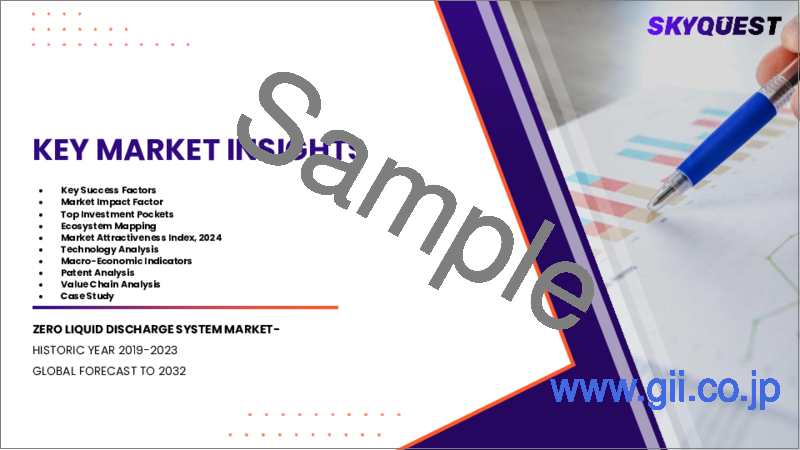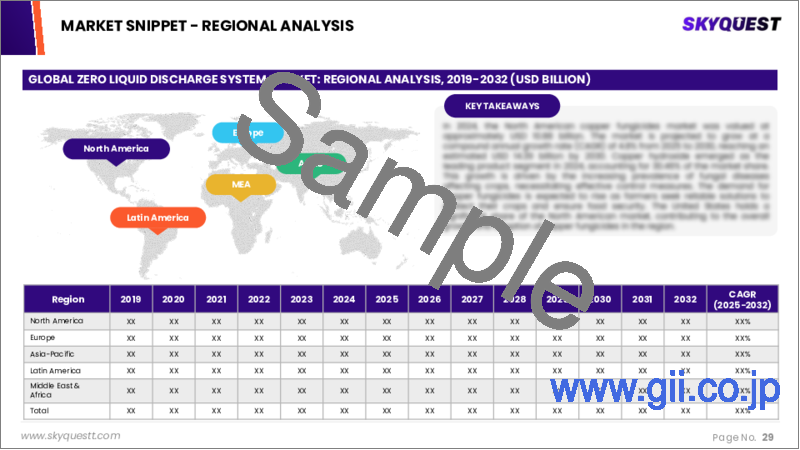|
|
市場調査レポート
商品コード
1658177
ゼロ液体排出システム市場規模、シェア、成長分析:プロセス別、容量別、技術別、用途別、システム別、最終用途産業別、地域別 - 産業予測 2025~2032年Zero Liquid Discharge System Market Size, Share, and Growth Analysis, By Process (Pretreatment, Filtration), By Capacity (Small Scale, Medium Scale), By Technology, By Application, By System, By End-Use Industry, By Region - Industry Forecast 2025-2032 |
||||||
|
|||||||
| ゼロ液体排出システム市場規模、シェア、成長分析:プロセス別、容量別、技術別、用途別、システム別、最終用途産業別、地域別 - 産業予測 2025~2032年 |
|
出版日: 2025年02月18日
発行: SkyQuest
ページ情報: 英文 182 Pages
納期: 3~5営業日
|
全表示
- 概要
- 目次
ゼロ液体排出システム市場規模は2023年に63億2,000万米ドルと評価され、2024年の68億4,000万米ドルから2032年には128億5,000万米ドルに成長し、予測期間(2025-2032年)のCAGRは8.2%で成長する見通しです。
ゼロ液体排出(ZLD)システムは、厳しい世界的規制によって産業廃水の排出をなくすことができるため、さまざまな産業で支持を集めています。これらのシステムは、廃水をリサイクル処理し、回収して産業活動に再利用することができます。企業が廃棄物管理コストの増大に直面する中、ZLDシステムは廃棄物量を最小限に抑え、現場での水リサイクル能力を高めることで、費用対効果の高いソリューションを提供します。これにより、敷地外での大規模な廃水治療の必要性を減らし、関連する車両排出や環境リスクを低減すると同時に、水の取得費用を削減することができます。ZLDシステムを集中型または分散型ユニットとして工場間の水ネットワークに統合することで、産業界は規制の圧力に戦略的に対応し、持続可能な産業慣行とエコロジカルフットプリントの削減への道を開きます。
目次
イントロダクション
- 調査の目的
- 調査範囲
- 定義
調査手法
- 情報調達
- 二次と一次データの方法
- 市場規模予測
- 市場の前提条件と制限
エグゼクティブサマリー
- 世界市場の見通し
- 供給と需要の動向分析
- セグメント別機会分析
市場力学と見通し
- 市場概要
- 市場規模
- 市場力学
- 促進要因と機会
- 抑制要因と課題
- ポーターの分析
主な市場の考察
- 重要成功要因
- 競合の程度
- 主な投資機会
- 市場エコシステム
- 市場の魅力指数(2024年)
- PESTEL分析
- マクロ経済指標
- バリューチェーン分析
- 価格分析
ゼロ液体排出システム市場規模:プロセス別& CAGR(2025-2032)
- 市場概要
- 前処理
- 濾過
- 蒸発/結晶化
ゼロ液体排出システム市場規模:容量別& CAGR(2025-2032)
- 市場概要
- 小規模
- 中規模
- 大規模
ゼロ液体排出システム市場規模:技術別& CAGR(2025-2032)
- 市場概要
- 逆浸透(RO)
- 限外濾過(UF)
- 蒸発と結晶化
ゼロ液体排出システム市場規模:用途別& CAGR(2025-2032)
- 市場概要
- 塩水処理
- 化学廃棄物
- 飲食品廃棄物
- エレクトロニクス
- その他の用途
ゼロ液体排出システム市場規模:システム別& CAGR(2025-2032)
- 市場概要
- 従来型
- ハイブリッド
ゼロ液体排出システム市場規模:最終用途産業別& CAGR(2025-2032)
- 市場概要
- エネルギーと電力
- 発電
- 石油・ガス
- 化学・石油化学製品
- 食品・飲料
- 繊維
- 医薬品
- 半導体・エレクトロニクス
- その他
ゼロ液体排出システム市場規模:地域別& CAGR(2025-2032)
- 北米
- 米国
- カナダ
- 欧州
- ドイツ
- スペイン
- フランス
- 英国
- イタリア
- その他欧州地域
- アジア太平洋地域
- 中国
- インド
- 日本
- 韓国
- その他アジア太平洋地域
- ラテンアメリカ
- ブラジル
- その他ラテンアメリカ地域
- 中東・アフリカ
- GCC諸国
- 南アフリカ
- その他中東・アフリカ
競合情報
- 上位5社の比較
- 主要企業の市場ポジショニング(2024年)
- 主な市場企業が採用した戦略
- 最近の市場動向
- 企業の市場シェア分析(2024年)
- 主要企業の企業プロファイル
- 企業の詳細
- 製品ポートフォリオ分析
- 企業のセグメント別シェア分析
- 収益の前年比比較(2022-2024)
主要企業プロファイル
- Alfa Laval(Sweden)
- AQUARION AG(Switzerland)
- Veolia Water Technologies Inc.(France)
- Aquatech International LLC(United States)
- GEA Group Aktiengesellschaft(Germany)
- Praj Industries Ltd(India)
- H2O GmbH(Germany)
- Thermax Limited(India)
- Mitsubishi Power Ltd(Japan)
- ANDRITZ(Austria)
- Toshiba Infrastructure Systems & Solutions Corporation(Japan)
- Condorchem Envitech(Spain)
- Kurita Water Industries Ltd(Japan)
- Evoqua Water Technologies LLC(United States)
- IDE Water Technologies(Israel)
- SafBon Water Technology(United States)
- Saltworks Technologies Inc.(Canada)
- Petro Sep Corporation(Canada)
- SUEZ(France)
- ENCON Evaporators(United States)
結論と提言
Zero Liquid Discharge System Market size was valued at USD 6.32 billion in 2023 and is poised to grow from USD 6.84 billion in 2024 to USD 12.85 billion by 2032, growing at a CAGR of 8.2% during the forecast period (2025-2032).
Zero Liquid Discharge (ZLD) Systems are gaining traction in various industries due to their ability to eliminate industrial wastewater discharge, driven by stringent global regulations. These systems treat wastewater through recycling, enabling its recovery and reuse for industrial operations. As companies face escalating waste management costs, ZLD systems present a cost-effective solution by minimizing waste volumes and enhancing onsite water recycling capabilities. This reduces the need for extensive offsite wastewater treatment, decreasing associated vehicle emissions and environmental risks, while simultaneously lowering water acquisition expenses. The integration of ZLD systems into interplant water networks as either centralized or distributed units offers industries a strategic response to regulatory pressures, paving the way for sustainable industrial practices and reduced ecological footprints.
Top-down and bottom-up approaches were used to estimate and validate the size of the Zero Liquid Discharge System market and to estimate the size of various other dependent submarkets. The research methodology used to estimate the market size includes the following details: The key players in the market were identified through secondary research, and their market shares in the respective regions were determined through primary and secondary research. This entire procedure includes the study of the annual and financial reports of the top market players and extensive interviews for key insights from industry leaders such as CEOs, VPs, directors, and marketing executives. All percentage shares split, and breakdowns were determined using secondary sources and verified through Primary sources. All possible parameters that affect the markets covered in this research study have been accounted for, viewed in extensive detail, verified through primary research, and analyzed to get the final quantitative and qualitative data.
Zero Liquid Discharge System Market Segments Analysis
Global Zero Liquid Discharge System Market is segmented by Process, Capacity, Technology, Application, System, End-Use Industry and region. Based on Process, the market is segmented into Pretreatment, Filtration and Evaporation/Crystallization. Based on Capacity, the market is segmented into Small Scale, Medium Scale and Large Scale. Based on Technology, the market is segmented into Reverse Osmosis (RO), Ultrafiltration (UF) and Evaporation and Crystallization. Based on Application, the market is segmented into Brine Disposal, Chemical Waste, Food & Beverage Waste, Electronics and Other Applications. Based on System, the market is segmented into Conventional and Hybrid. Based on End-Use Industry, the market is segmented into Energy & Power, Power Generation, Oil & Gas, Chemicals & Petrochemicals, Food & Beverages, Textiles, Pharmaceuticals, Semiconductor & Electronics and Others. Based on region, the market is segmented into North America, Europe, Asia Pacific, Latin America and Middle East & Africa.
Driver of the Zero Liquid Discharge System Market
The Zero Liquid Discharge (ZLD) System market is significantly driven by rapid industrialization and the growing scarcity of fresh water, particularly due to an increasing global population reliant on dwindling freshwater resources. The challenge of salination is especially pronounced in regions like the Middle East. To address this issue, Dusan Energy announced a substantial investment of $840 billion in August 2022 to construct a seawater desalination facility in Saudi Arabia. ZLD systems play a crucial role by converting seawater into potable water, thereby fulfilling the essential demand for freshwater needed for drinking, industrial activities, and domestic purposes.
Restraints in the Zero Liquid Discharge System Market
The Zero Liquid Discharge System market faces significant challenges primarily due to the high initial investment and capital expenditure required for implementation. This financial burden has impeded market expansion. As a viable alternative, various wastewater treatment solutions with lower operational costs have emerged, allowing manufacturers and municipal authorities to efficiently recover approximately 95% of liquid discharge. These alternatives present a more cost-effective option, attracting stakeholders seeking to minimize expenses while still managing wastewater effectively. Consequently, the prevalence of these alternative solutions poses a restraint on the growth potential of the Zero Liquid Discharge System market.
Market Trends of the Zero Liquid Discharge System Market
The Zero Liquid Discharge (ZLD) System market is witnessing a significant upward trend, driven by increasing environmental regulations and growing awareness of water scarcity. As industries prioritize sustainable practices, the ZLD process emerges as a viable solution for water conservation, enabling the recovery and reuse of treated water while eliminating wastewater discharge. This trend is particularly prominent in sectors such as mining, pharmaceuticals, and textiles, where water management is critical. Technological advancements and government incentives further bolster market growth, positioning ZLD systems as essential investments for companies aiming to enhance operational efficiency and environmental responsibility, thereby attracting increased market interest and investment.
Table of Contents
Introduction
- Objectives of the Study
- Scope of the Report
- Definitions
Research Methodology
- Information Procurement
- Secondary & Primary Data Methods
- Market Size Estimation
- Market Assumptions & Limitations
Executive Summary
- Global Market Outlook
- Supply & Demand Trend Analysis
- Segmental Opportunity Analysis
Market Dynamics & Outlook
- Market Overview
- Market Size
- Market Dynamics
- Drivers & Opportunities
- Restraints & Challenges
- Porters Analysis
- Competitive rivalry
- Threat of substitute
- Bargaining power of buyers
- Threat of new entrants
- Bargaining power of suppliers
Key Market Insights
- Key Success Factors
- Degree of Competition
- Top Investment Pockets
- Market Ecosystem
- Market Attractiveness Index, 2024
- PESTEL Analysis
- Macro-Economic Indicators
- Value Chain Analysis
- Pricing Analysis
Global Zero Liquid Discharge System Market Size by Process & CAGR (2025-2032)
- Market Overview
- Pretreatment
- Filtration
- Evaporation/Crystallization
Global Zero Liquid Discharge System Market Size by Capacity & CAGR (2025-2032)
- Market Overview
- Small Scale
- Medium Scale
- Large Scale
Global Zero Liquid Discharge System Market Size by Technology & CAGR (2025-2032)
- Market Overview
- Reverse Osmosis (RO)
- Ultrafiltration (UF)
- Evaporation and Crystallization
Global Zero Liquid Discharge System Market Size by Application & CAGR (2025-2032)
- Market Overview
- Brine Disposal
- Chemical Waste
- Food & Beverage Waste
- Electronics
- Other Applications
Global Zero Liquid Discharge System Market Size by System & CAGR (2025-2032)
- Market Overview
- Conventional
- Hybrid
Global Zero Liquid Discharge System Market Size by End-Use Industry & CAGR (2025-2032)
- Market Overview
- Energy & Power
- Power Generation
- Oil & Gas
- Chemicals & Petrochemicals
- Food & Beverages
- Textiles
- Pharmaceuticals
- Semiconductor & Electronics
- Others
Global Zero Liquid Discharge System Market Size & CAGR (2025-2032)
- North America (Process, Capacity, Technology, Application, System, End-Use Industry)
- US
- Canada
- Europe (Process, Capacity, Technology, Application, System, End-Use Industry)
- Germany
- Spain
- France
- UK
- Italy
- Rest of Europe
- Asia Pacific (Process, Capacity, Technology, Application, System, End-Use Industry)
- China
- India
- Japan
- South Korea
- Rest of Asia-Pacific
- Latin America (Process, Capacity, Technology, Application, System, End-Use Industry)
- Brazil
- Rest of Latin America
- Middle East & Africa (Process, Capacity, Technology, Application, System, End-Use Industry)
- GCC Countries
- South Africa
- Rest of Middle East & Africa
Competitive Intelligence
- Top 5 Player Comparison
- Market Positioning of Key Players, 2024
- Strategies Adopted by Key Market Players
- Recent Developments in the Market
- Company Market Share Analysis, 2024
- Company Profiles of All Key Players
- Company Details
- Product Portfolio Analysis
- Company's Segmental Share Analysis
- Revenue Y-O-Y Comparison (2022-2024)
Key Company Profiles
- Alfa Laval (Sweden)
- Company Overview
- Business Segment Overview
- Financial Updates
- Key Developments
- AQUARION AG (Switzerland)
- Company Overview
- Business Segment Overview
- Financial Updates
- Key Developments
- Veolia Water Technologies Inc. (France)
- Company Overview
- Business Segment Overview
- Financial Updates
- Key Developments
- Aquatech International LLC (United States)
- Company Overview
- Business Segment Overview
- Financial Updates
- Key Developments
- GEA Group Aktiengesellschaft (Germany)
- Company Overview
- Business Segment Overview
- Financial Updates
- Key Developments
- Praj Industries Ltd (India)
- Company Overview
- Business Segment Overview
- Financial Updates
- Key Developments
- H2O GmbH (Germany)
- Company Overview
- Business Segment Overview
- Financial Updates
- Key Developments
- Thermax Limited (India)
- Company Overview
- Business Segment Overview
- Financial Updates
- Key Developments
- Mitsubishi Power Ltd (Japan)
- Company Overview
- Business Segment Overview
- Financial Updates
- Key Developments
- ANDRITZ (Austria)
- Company Overview
- Business Segment Overview
- Financial Updates
- Key Developments
- Toshiba Infrastructure Systems & Solutions Corporation (Japan)
- Company Overview
- Business Segment Overview
- Financial Updates
- Key Developments
- Condorchem Envitech (Spain)
- Company Overview
- Business Segment Overview
- Financial Updates
- Key Developments
- Kurita Water Industries Ltd (Japan)
- Company Overview
- Business Segment Overview
- Financial Updates
- Key Developments
- Evoqua Water Technologies LLC (United States)
- Company Overview
- Business Segment Overview
- Financial Updates
- Key Developments
- IDE Water Technologies (Israel)
- Company Overview
- Business Segment Overview
- Financial Updates
- Key Developments
- SafBon Water Technology (United States)
- Company Overview
- Business Segment Overview
- Financial Updates
- Key Developments
- Saltworks Technologies Inc. (Canada)
- Company Overview
- Business Segment Overview
- Financial Updates
- Key Developments
- Petro Sep Corporation (Canada)
- Company Overview
- Business Segment Overview
- Financial Updates
- Key Developments
- SUEZ (France)
- Company Overview
- Business Segment Overview
- Financial Updates
- Key Developments
- ENCON Evaporators (United States)
- Company Overview
- Business Segment Overview
- Financial Updates
- Key Developments





